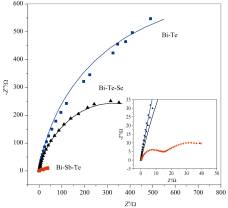1 Tritt, T. M.; Subramanian, M. A. MRS Bull. 2006, 31, 188.  2 Yoo, B. Y.; Huang, C. K.; Lim, J. R.; Herman, J.; Ryan, M. A.; Fleurial, J. P.; Myung, N. V. Electrochim. Acta 2005, 50,4371. 2 Yoo, B. Y.; Huang, C. K.; Lim, J. R.; Herman, J.; Ryan, M. A.; Fleurial, J. P.; Myung, N. V. Electrochim. Acta 2005, 50,4371.  3 Michel, S.; Diliberto, S.; Boulanger, C.; Bolle, B. J. Cryst. Growth 2006, 296, 227. 3 Michel, S.; Diliberto, S.; Boulanger, C.; Bolle, B. J. Cryst. Growth 2006, 296, 227.  4 Michel, S.; Diliberto, S.; Boulanger, C.; Stein, N.; Lecuire, J. M. J. Cryst. Growth 2005, 277, 274. 4 Michel, S.; Diliberto, S.; Boulanger, C.; Stein, N.; Lecuire, J. M. J. Cryst. Growth 2005, 277, 274.  5 Miyazaki, Y.; Kajitani, T. J. Cryst. Growth 2001, 229, 542. 5 Miyazaki, Y.; Kajitani, T. J. Cryst. Growth 2001, 229, 542.  6 Del Frari, D.; Diliberto, S.; Stein, N.; Boulanger, C.; Lecuire, J. M. J. Appl. Electrochem. 2006, 36, 449. 6 Del Frari, D.; Diliberto, S.; Stein, N.; Boulanger, C.; Lecuire, J. M. J. Appl. Electrochem. 2006, 36, 449.  7 Martín-González, M.; Prieto, A. L.; Gronsky, R.; Sands, T.; Stacy, A. M. Adv. Mater. 2003, 15, 1003. 7 Martín-González, M.; Prieto, A. L.; Gronsky, R.; Sands, T.; Stacy, A. M. Adv. Mater. 2003, 15, 1003.  8 Del Frari, D.; Diliberto, S. b. D.; Stein, N.; Boulanger, C.; Lecuire, J.-M. Thin Solid Films 2005, 483, 44. 8 Del Frari, D.; Diliberto, S. b. D.; Stein, N.; Boulanger, C.; Lecuire, J.-M. Thin Solid Films 2005, 483, 44.  9 Bu, L.; Wang, W.; Wang, H. Appl. Surf. Sci. 2007, 253,3360. 9 Bu, L.; Wang, W.; Wang, H. Appl. Surf. Sci. 2007, 253,3360.  10 Bu, L.; Wang, W.; Wang, H. Mater. Res. Bull. 2008, 43,1808. 10 Bu, L.; Wang, W.; Wang, H. Mater. Res. Bull. 2008, 43,1808.  11 Montiel Santillan, T.; Solorza Feria, O.; Sanchez Soriano, H. Int. J. Hydrogen Energy 2002, 27, 461. 11 Montiel Santillan, T.; Solorza Feria, O.; Sanchez Soriano, H. Int. J. Hydrogen Energy 2002, 27, 461.  12 Takahashi, M.; Oda, Y.; Ogino, T.; Furuta, S. J. Electrochem. Soc. 1993, 140, 2550. 12 Takahashi, M.; Oda, Y.; Ogino, T.; Furuta, S. J. Electrochem. Soc. 1993, 140, 2550.  13 Golia, S.; Arora, M.; Sharma, R. K.; Rastogi, A. C. Curr. Appl. Phys. 2003, 3, 195. 13 Golia, S.; Arora, M.; Sharma, R. K.; Rastogi, A. C. Curr. Appl. Phys. 2003, 3, 195.  14 Jin, C. G.; Xiang, X. Q.; Jia, C.; Liu, W. F.; Cai, W. L.; Yao, L. Z.; Li, X. G. J. Phys. Chem. B 2004, 108, 1844. 14 Jin, C. G.; Xiang, X. Q.; Jia, C.; Liu, W. F.; Cai, W. L.; Yao, L. Z.; Li, X. G. J. Phys. Chem. B 2004, 108, 1844.  15 Li, F. H.; Jia, F. L.; Wang, W. Appl. Surf. Sci. 2009, 255,7394. 15 Li, F. H.; Jia, F. L.; Wang, W. Appl. Surf. Sci. 2009, 255,7394.  16 Martin-Gonzalez, M.; Prieto, A. L.; Gronsky, R.; Sands, T.; Stacy, A. M. J. Electrochem. Soc. 2002, 149, C546. 16 Martin-Gonzalez, M.; Prieto, A. L.; Gronsky, R.; Sands, T.; Stacy, A. M. J. Electrochem. Soc. 2002, 149, C546.  17 Li, S. H.; Toprak, M. S.; Soliman, H. M. A.; Zhou, J.; Muhammed, M.; Platzek, D.; Muller, E. Chem. Mater.2006, 18, 3627. 17 Li, S. H.; Toprak, M. S.; Soliman, H. M. A.; Zhou, J.; Muhammed, M.; Platzek, D.; Muller, E. Chem. Mater.2006, 18, 3627.  18 Li, S. H.; Soliman, H. M. A.; Zhou, J.; Toprak, M. S.; Muhammed, M.; Platzek, D.; Ziolkowski, P.; Muller, E. Chem. Mater. 2008, 20, 4403. 18 Li, S. H.; Soliman, H. M. A.; Zhou, J.; Toprak, M. S.; Muhammed, M.; Platzek, D.; Ziolkowski, P.; Muller, E. Chem. Mater. 2008, 20, 4403.  19 Qiu, L. Q.; Zhou, J. A.; Cheng, X. A.; Ahuja, R. J. Phys. Chem. Solids 2010, 71, 1131. 19 Qiu, L. Q.; Zhou, J. A.; Cheng, X. A.; Ahuja, R. J. Phys. Chem. Solids 2010, 71, 1131.  |
